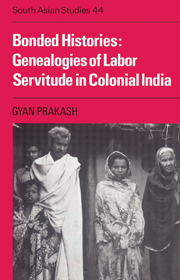Book contents
- Frontmatter
- Contents
- List of illustrations
- List of tables
- Preface
- Conventions followed in the text
- List of abbreviations
- Introduction: the discourse of freedom
- 1 Places of bondage
- 2 True stories
- 3 Land is to objectify
- 4 Freedom found and lost
- 5 Contested power
- Conclusion: freedom bound
- Appendix
- Glossary
- Bibliography
- Index
- CAMBRIDGE SOUTH ASIAN STUDIES
1 - Places of bondage
Published online by Cambridge University Press: 22 September 2009
- Frontmatter
- Contents
- List of illustrations
- List of tables
- Preface
- Conventions followed in the text
- List of abbreviations
- Introduction: the discourse of freedom
- 1 Places of bondage
- 2 True stories
- 3 Land is to objectify
- 4 Freedom found and lost
- 5 Contested power
- Conclusion: freedom bound
- Appendix
- Glossary
- Bibliography
- Index
- CAMBRIDGE SOUTH ASIAN STUDIES
Summary
… the importance of the Kamia to the economics of the district [Gaya] can be gauged from the amount of dispute that went on about his land.
Final Report on the Survey and Settlement Operations in the District of Gaya, 1911–18… the pity is that in Gaya a hide-bound system has condemned the more degraded of them to a poverty which could not exist under the operation of economic laws; for the demand for labour is very considerable while the supply is not excessive; yet numbers for the sake of a few rupees sell themselves and their children after them into miserable bondage.
C.J. Stevenson-Moore, Report on the Material Condition of Small Agriculturists and Labourers in Gaya, 1898Colonial records represented nineteenth-century Bihar as a distinct entity consisting of a range of differences. Although differentiated in terms of agricultural practices, cultural features, and labor relations, and attached to the Bengal Presidency until 1912 when, together with Orissa, it was disengaged from Bengal before finally emerging as a separate province in 1936, the colonial administration treated Bihar nonetheless as a well-defined region. Of course, because it had been a province (subā) in the Mughal empire (deriving its name from the existence of a number of Buddhist monasteries, vihāras, in the area), Bihar's separate identity pre-dated British rule.
- Type
- Chapter
- Information
- Bonded HistoriesGenealogies of Labor Servitude in Colonial India, pp. 13 - 33Publisher: Cambridge University PressPrint publication year: 1990



